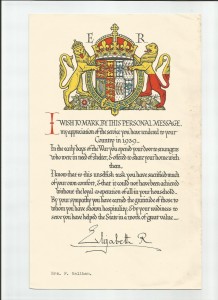September 1939 saw Britain enter the Second World War against Germany. Across the UK this was to have a profound effect on daily life and Hanslope was no exception. This article outlines some of the changes, experiences and events that took place in the village and surrounding area during this period. We hope to add to this and welcome your recollections, further information and photographs.
Rationing
The first major change felt by all was the introduction of rationing across the UK. Within a few weeks, the first commodity to be controlled was petrol, with a restriction on the amount available to motorists per month. Although the level of car ownership in Hanslope was a fraction of what we see today, the restriction would have had an impact on non-essential travel and deliveries into and out of the village.
Non-food items, such as clothing and shoes were also rationed. A points system was introduced, initially providing 66 points per person. This didn’t go very far – an overcoat was 18 points; a pair of woman’s shoes 9 points. The number of buttons, pockets and even pleats on skirts were limited. The result was ‘make do and mend’ particularly for the children, with the same coat or pair of shoes often being passed down through numerous children throughout the village.
On 8 January 1940, butter, bacon and sugar were rationed nationally. This was followed by other essentials such as meat, cheese, eggs, lard, milk, breakfast cereals and canned fruit. By August 1942, rationing had extended to almost all foods, apart from vegetables and bread. One villager recalled that as a boy, he didn’t go hungry but missed sweets – the only ones available being cough sweets! They used to have scoops of Cocoa from a drum at the shop instead.
Fresh vegetables and fruit were not rationed but supplies were limited. Spurred on by the Government’s ‘dig for victory’ campaign, many in Britain had by then started to grow their own vegetables in their gardens. Hanslope villagers did the same and within months, many gardens became vegetable patches, with some keeping chickens, pigs and goats too. The majority of produce from the local farms went to supporting national needs. More on that later.
Alongside the rationing, there was also a country-wide call for scrap metal to help the war effort. Villagers gave old pots, pans and farming scrap machinery. Iron railings were also targeted and as a result, several sets were removed from around the village for recycling, including the old iron railings outside the Globe Inn in Long Street. Railings from the Top and Bottom Schools and Church also went, leaving only the gates. Although the church walls were rebuilt shortly after the war, the stumps of the original metal railings fronting Hanslope’s ‘Top School’ (now the Village Hall) can still be seen.
Not all efforts seem to have been as appreciated. Parish records of 12 Aug 1940 state that a collection of old iron had been made by the WI and the heap collected was estimated at about 5 or 6 tons. However, one villager recalled that although this was collected it was left in a field, and no one did anything with it.
Air Raid Precautions
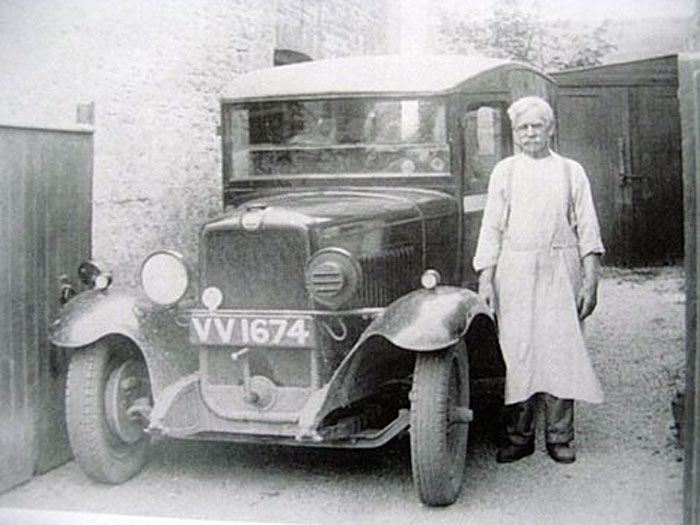
Just before war began the Government ordered a national blackout, in anticipation of the air raids to come. The village’s street lights were switched off, or dimmed. Light from any windows had to be prevented from escaping, using heavy curtains or old blankets. Vehicle headlamps were covered up, except for narrow slots which cast the bare minimum of light downwards onto the road. On a moonless night the village would have been shrouded in an inky blackness that made a simple walk up the high street difficult. With no light pollution, at least the view of the stars on such nights was amazing!
Windows had to be protected with a cross of brown paper sticky tape, to reduce the danger from flying glass in the event of an air raid. As well as obscuring the view, one villager remarked this also made cleaning her windows more difficult.
As for air raid shelters, it appears that there weren’t any air raid shelters in Hanslope during the war; the children just got under the kitchen table. As a child, one villager recalled sleeping under the stairs some evenings. If nothing else it might have been a little quieter.
On 8 July 1940, a request by the air raid wardens was considered by the council in regard to the erection of a pubic air raid shelter in the parish. The clerk was instructed to write to the authorities on this subject, but this doesn’t seem to have gone any further.

The village bobby of the time was PC Albert John Keen, who was the Hanslope village policeman from May 1937 until May 1947. In common with many villages, he also became the Air Raid Warden, as part of Hanslope’s Air Raid Precautions (ARP). Part of his new role would have been to patrol the village after dark, and check that no light could be seen. Any light escaping from curtains not fully closed after dusk would result in a knock on the door. The ARP base was situated in two small old railway carriages, next to what used to be the old garage at the north end of the high street.
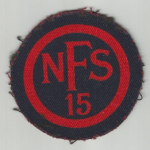
Other buildings appeared in support of the War Effort at this time. One villager recalled a wooden hut containing a NAAFI Canteen, based in the vicinity of Town Yard in Hanslope. This was apparently very popular with soldiers and staff from nearby Hanslope Park.
In the event of a fire from an air raid, Hanslope did not have its own fire station, the nearest being Wolverton, some 6 miles away. Instead, the village relied on an elderly hand-pulled fire pump, kept at the Old Vicarage. Sid Keeves, ‘Tock’ Herbert and Hughie Gregory were amongst the village’s volunteer firemen who would have been expected to fight any fires, although thankfully, it appears their services were not often required.
In 1942 the National Fire Service took over responsibility for the local fire service, previously run by the local council; this was in response to the threat of possible air raids on the country. Villager Tony Bellham was a teenager at the time and became one of Hanslope’s NFS volunteers.
Evacuees and new residents
At the outbreak of the war the authorities initiated evacuation plans, which relocated civilians, mainly children, out of the major cities now under threat from bombing. In the event, nearly 1.5 million people were evacuated to ‘reception zones’ within rural areas.
From the start Hanslope saw an influx of evacuees, mostly young children from London and the Midlands. One villager recalled the day two bus-loads of children from London arrived outside the Watts Arms.
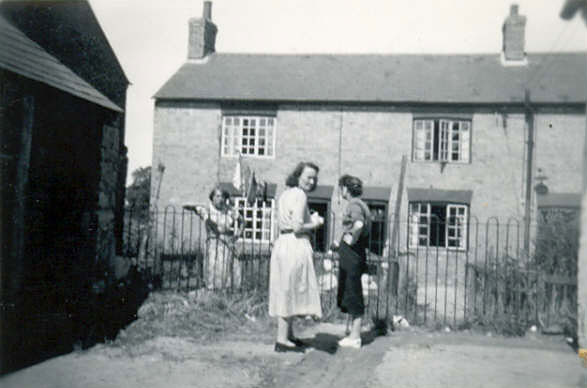
Officials then went up the high street, knocking on doors and handing over children. Most had never been away without their families; many had not seen the countryside before. Few realised that milk came from cows! One told of the need to wrap brown paper around their table legs, to prevent damage from their boisterous new children kicking them.
So it was that a number of village families took in evacuees, with some spending several years here. Many truly became part of the family and close ties remain to this day.
Others simply sought to escape the City and move their whole families to the relative safety of the village. Archie Robertson bought or rented some houses in Gladstone Terrace during the war for his wife and sisters and their children to live in, to get out of London.
For one Hanslope family at least, their kindness to the evacuees was officially recognised. Later in the war, Tony Bellham’s family were surprised to receive these thanks, from Buckingham Palace.
Hanslope’s Home Guard
Initially known as the Local Defence Volunteers or LDV, the Home Guard came into being nationally in 1940. In total, some 1.5 million volunteered across the UK. Due to their age or medical condition, they were otherwise ineligible for military service. Hanslope’s Home Guard was made of local volunteers, mostly middle aged, led by a regular army officer. When not farming or involved in their day trades, they could be heard training and shooting on the fields near what is now the Hanslope Equestrian Centre.
One villager recalled they used to initially meet at St James’ Church, until it was realised they were bringing their rifles in with them! After this, the Home Guard met elsewhere and for the duration of the war were based in an outbuilding behind the Watts Arms. The landlord of the time was also reputedly a member.
The Home Guards’ main role was to protect the village and its approaches, and disrupt the enemy’s advance should Britain be invaded. One villager recalled that an early attempt at ‘confusing and hindering the enemy’ was to remove the village’s road signs at the cross roads and approaches to the village. Unfortunately, this served only to confuse anyone other than a local! As a result the road signs were quickly reinstated.
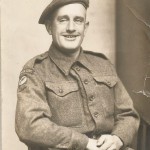
At least one of the Home Guard went on to serve in the regular army later in the War. Barbara Stimson (Belham)’s father, J G Stimson, left the village to serve in the Royal Pioneer Corps, landing in Normandy the day after D-Day. He was to see active service through France and into Germany until the war ended.
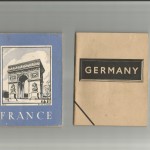
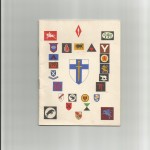 J G Stimpson’s Army country guides and end of war thanksgiving ceremony hymn book.
J G Stimpson’s Army country guides and end of war thanksgiving ceremony hymn book.
Air Raids
1940 saw the start of intensive air raids by the German air force (Luftwaffe), with the Midlands extensively targeted on a nightly basis. Hanslope villagers recall the drone of the bombers as they headed north towards Coventry and Birmingham – the nearby train line north being used as a navigation aid by the Luftwaffe’s bombers. They could also hear the distant wail of air raid sirens at Wolverton as they passed over there. To the north, they would hear the anti-aircraft fire and the rumble of bombs reaching their targets. At the time of the Blitz in 1940, villagers Tony and Barbara Belham recall being able to see flashes and the glow of distant fires to the south, visible from Long Street.
For villager Sheila Elliot, a child during the War, the experience was more first hand. Out walking with her mother one evening early in the war, she recollected being pushed down behind a wall, facing the fields off Western Drive, as a German bomber dropped some of its load in the fields to West of Long Street.
This would seem to be borne out by County records of bombs dropped in the Hanslope area. Records show there were 3 recorded air raid incidents:
- One near what is now Hanslope Surgery on 15 March 1941 (suspected unexploded bomb);
- One on Hanslope Recreation ground, just south of the where the Children’s play area is now, causing no damage, on 19 March 1941;
- And an exploding bomb or bombs causing damage to 18 buildings in the vicinity of Model Farm, Long Street on 9 November, 1940. Could this have been the bombing Shelia and her Mother witnessed?
Hanslope Air raids : 1939 – 45

In addition, two more incidents were recalled by villagers from Long Street that do not appear to have been recorded.
- An incendiary bomb in late 1940, that set fire to farm buildings at a farm just south of the junction of Forest Road and Hartwell Road.
- A larger bomb, landing on the bridleway leading to Chancery Farm, North West of Long Street. This is said to have left a substantial mound of earth from the explosion and was reputed to have been dropped the week before the Coventry Blitz of November 1940.
An attack of a different nature took place at this time. Villager Barbara Bellham recalls as a young teenager, witnessing scores of wounded being helped from the train at Castlethorpe. Apparently, the train had been strafed by the machine guns of a German fighter between Bletchley and Wolverton.
Her soon to be husband Tony also was left with an indelible experience later in the war. In June 1944, having now started work at a factory in nearby Roade, he was returning home at around 5pm when he witnessed a Wellington bomber being struck by lightning, exploding and plummeting to earth. Sadly, the Canadian crew, out on a training flight, all perished in the crash.
Salcey Forest during World War II
From 1 March 1942, nearby Salcey Forest became home to the RAF’s No.72 Maintenance Unit Squadron, as an Equipment Dispersal Depot. Initially a storage facility for aircraft engine spares, it quickly expanded to become a major depot for all manner of ground equipment needed by the region’s airbases.
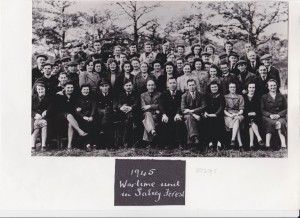
As it grew in size it employed many villagers from Hartwell and Hanslope to work in the stores there, a round-the-clock operation. The site also had its rail spur from the mainline. Trains and trucks could be distantly heard moving into and out of the site throughout the day and night.
Late in the war, one villager recalled a morale-boosting concert laid on for the workers at Salcey depot which included a performance by a very young trio, the Beverley Sisters. The girls were a highlight of the evening and went on to sing alongside Glenn Miller’s Orchestra. Soon after the war they were to sign a recording contract with Columbia Records and become the highest paid female act in the UK with a string of hits. They would still be performing together as recently as 2009, entering the Guinness Book of Records as the longest surviving female trio act.
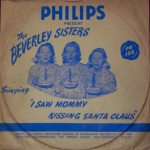
Recent contact by the author with the surviving ‘Bevs’ about their performance brought a surprising response in the mail. Not only did they fondly recall the performance – it was their first. They had many happy memories of this period and as a thank you for reminding them of that time, included a signed picture of the trio, dedicated to the people of Hanslope. This can now be seen in the Village Hall.
The arrival of the elephants
As the depot grew, a large number of trees had to be felled and cleared. Villager Tony Bellham worked at the depot as a teenager and recalls a steam traction engine in use for this purpose. But this proved unreliable and despite their best efforts finally become unrepairable.
It was determined that elephants might be a better means to clear the logs from the forest, a role they had been successfully employed in for centuries in India and East Asia. Castlethorpe villagers witnessed the sight of two elephants unloaded from a train at their station. The elephants had become separated from a travelling circus and were then residing on a farm in Duston, near Northampton. Reportedly, the role of driving the elephants fell to one Sabu Dastagir.
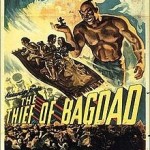 Sabu was a famous Indian child actor, starring at that time in the production of The Thief of Bagdad, a British Technicolor film being filmed at Pinewood Studios near London. The story goes that Sabu was famed for his skill in driving elephants and was asked to ensure their safe transit to Salcey.
Sabu was a famous Indian child actor, starring at that time in the production of The Thief of Bagdad, a British Technicolor film being filmed at Pinewood Studios near London. The story goes that Sabu was famed for his skill in driving elephants and was asked to ensure their safe transit to Salcey.

One local account recalls Sabu leading them up Castlethorpe Road to Salcey Forest, a route which would have taken them past the Watts Arms, up Long Street Road, then right down Forest Road to the Salcey Depot. There the Elephants were put to work in clearing the forest for the buildings and facilities, with their day to day care falling to a Sinagalese mahout keeper, called Khanades Karunadasa. After the war, the elephants ended up at Chester Zoo. To this day, Elephant Walk and Elephant Pond (where they drank) can be visited in the Forest.
Sabu didn’t stay in the UK for much longer. Although filming started in England, due to the outbreak of World War 11, filming was completed in California. In 1944, at the age of 20, he became an American citizen and joined the US Air Force, where he served as a combat tail gunner in the Pacific.
As for Salcey Depot itself, the site was to exist until 1957 when it was dismantled, all remaining now being a few stretches of overgrown concrete in the woods to the north of Forest Road.
Nearby Prisoners of War
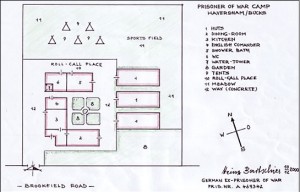
Nearby Haversham was chosen as the site for a prisoner of war (POW) camp. Built in 1943, initially it housed Italians and later German prisoners. Around 140 were held in a compound surrounded by barbed wire fencing on 18ft wooden posts. The camp was initially tents but later the prisoners built their own billets, made of prefabricated concrete sections.
For Hanslope, with many either on active service or otherwise engaged in the war effort, the POWs became a much needed source of labour for the local farms. One villager recalls as a teenager seeing Italian and German POWs working the land at Tathall End farm. At the age of 14, she was also proposed to by one of each nationality within a matter of months! The POWs were reputedly good workers and happy to be out of the war, many making friendships with the local villagers that continue to this day. Some settled in the area after the war.
Hanslope Park
Much has already been written about Hanslope Park and its wartime contribution. The Park grew substantially in size with thousands of workers during the war period, many of which would visit the village on their days or evenings off. Officers from the park took rooms in the village and for several years the Navy, Army and Air Force Institutes (NAAFI) had a café, situated in wooden huts near the crossroads that was very popular with service men and woman from the site.
During this period, it is reputed that leading figures of the time, including General Eisenhower, Field Marshall Montgomery and even Winston Churchill visited Hanslope Park. A little known fact was that later in the war, Hanslope Park was also home to Alan Turing, the famous code breaker.
For two days a week for six months he would cycle to Hanslope Park, before moving into the Officers Mess in 1944. He came to Hanslope to work on a speech scrambling system, which would allow a telephone conversation to take place without being easily listened into. In his spare time, Alan was also a keen runner. It would be nice to imagine he would sometimes take a route through Hanslope, as many do so today.
This has been a quick round up of some of the findings from recent research and accounts from a number of Hanslope’s residents from the period. Special thanks to Betty and Gerald Keeves, Tony and Barbara Bellham, Mr Roger Castle-Smith, Mrs Priscilla Parry, Mrs Enid Scarsbrook, Mrs Sheila Elliot and Mr Don Hellings for your accounts.
Thank you also to Mrs Phyllis Brockhurst and Ms Kirsten Ash, for all their support and additional information provided.
written by Daran Scarlett
References
- Sabu and the Elephants of Salcey: Walk of the Month – Telegraph 30th June 2007: http://www.telegraph.co.uk/travel/destinations/europe/uk/southernengland/737614/Walk-of-the-month.htmlThe
- Elephants of Salcey Forest – Aston Malone, Hanslope Clarion, December 2012
- Records of bombs dropped in and around Hanslope: For more details please see http://www.buckscc.gov.uk/leisure-and-culture/centre-for-buckinghamshire-studies/online-resources/bombs-over-bucks/#.UsR82J1FDt4
- WW2 Policing /ARP Support in Hanslope – Michael Mick Shaw, Bucks Constabulary website: http://www.mkheritage.co.uk/bch/
- Italian POW Camp in Haversham – Anton Cadman: http://www.mkheritage.co.uk/hav/docs/camp/camp.html
- Wellington Bomber Crash – Michael Gibson. ‘Aviation in Northamptonshire’ ISBN-10: 090539108X
